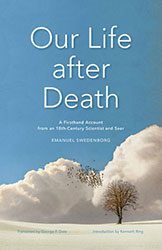 A wise theologian once noted that we should not speculate on the furniture of heaven or the temperature of hell. Obviously, Emanuel Swedenborg did not take his advice. In Our Life After Death, Swedenborg graphically describes his mystic vision of heaven, hell, and the postmortem experiences of humankind. In contrast to the generally rosy scenes described in most near death experiences, Swedenborg claims direct knowledge of hellish as well as heavenly states. We can’t run away from our lives, even in the afterlife, and our attitudes and values lead to heaven or hell after we die.
A wise theologian once noted that we should not speculate on the furniture of heaven or the temperature of hell. Obviously, Emanuel Swedenborg did not take his advice. In Our Life After Death, Swedenborg graphically describes his mystic vision of heaven, hell, and the postmortem experiences of humankind. In contrast to the generally rosy scenes described in most near death experiences, Swedenborg claims direct knowledge of hellish as well as heavenly states. We can’t run away from our lives, even in the afterlife, and our attitudes and values lead to heaven or hell after we die.
Personal identity is essential to Swedenborg’s vision of the afterlife. Our moral gravitation, spiritual orientation, and ultimate concern propel us toward particular destinations in the afterlife. Who we are and what we’ve done carries over and determines our next steps in our postmortem journeys. There is self-awareness in the afterlife; we learn who we truly are without masks, and discover that our identities will shape the future in apparently irrevocable and unbending ways.
Like Swedenborg, I think personal identity is central to the afterlife. One of my main questions regarding reincarnation or transmigration, whether Hindu, Buddhist, or new age, is the value of our future – or past – lives if we lack conscious self-awareness of our identity from life to life. We experience the impact of our past lives – the karmic energy of the past – but have no awareness of why we were born to happy or painful families or have certain gifts and limitations.
I believe that there is a pathway that embraces the insights of reincarnation, the “orthodox” Christian images of heaven and hell, and Swedenborg’s mystical vision of heaven and hell. This vision takes personal responsibility seriously but sees the afterlife as involving a community of evolving persons, shaped by grace and love. Universal healing and salvation await all of us, even though we must come to terms with the ambiguities and imperfections of our present life experiences.
Recently a distraught mother asked me, “Where is Susie now?” Her concern was far from academic, for her daughter had committed suicide just a few months earlier. Although I believe it is a good Christian pratice to be agnostic about the exact nature of the afterlife, I responded, “I believe that God loved her when she was born, that God loved her when she took her life, and God loves her now.” God’s love is never coercive, but always encouraging creativity and freedom in this life and the next.
Justice is done in this life and the next, but neither death nor our imperfection can ultimately defeat God. Our final earthly breath is not the end of God’s care or presence in our lives. God continues to lure us forward with loving possibilities in death and beyond. The afterlife is a time for growth, evolution, forgiveness, and healing. We must accept our life journey in all its ambiguity and complexity, but our self-acceptance occurs in an environment weighted toward grace. Although we can temporarily resist and slow down the arc of grace, God’s grace is persistent, unswerving, and ultimately irresistible. In the ongoing flow of experience, I believe that we will experience our loved ones, forgive and be forgiven, and rejoice in the beauty of our relationships.
In this lifetime, I believe that God is constantly presenting us with creative possibilities, building on our past and luring us toward the future. God will continue to offer us an array of possibilities in the afterlife, refining the influence of this lifetime and urging us toward life abundant in community with others. Living in the divine community of grace, we can grow from glory to glory. The afterlife is not a place of boredom, but a place of adventure and creativity.
We don’t know the exact relationship of this life and the next. We may become indifferent to this world and our earthly companions. We may also discover that our postmodern vocation is to help our earthly loved ones become more congruent with God’s vision for their lives. We may be called in to challenge, energize, and help them stay on the pathways of wholeness.
A Christian theologian once speculated that one of the joys of heaven will be our ability to hear the cries of the damned and give thanks for our salvation, knowing that but for the grace of God we might be among the damned. Such visions are far too small for a truly life-affirming and grace-embracing faith. The joys of heaven expand with every soul who finds its way homeward to God. In contrast to Swedenborg, I believe that personal identity can and will be transformed beyond the grace: the heaviness of the past and our personal decisions will shape the contours of our entry to the afterlife. Still, it is God and not the demonic that greet us as we take our last breath, and God’s judgment – like that of an expert surgeon – is always defined by the quest for healing.
As one text asserts, “heaven is for real.” Heaven is an adventure in soul-making in which we grow in love, compassion, and hospitality. We live out the abundant life in a world in which interdependence inspires care and creativity and the birth of a heart as big as the universe and beyond.
For more on Our Life After Death, visit the Patheos Book Club here.













